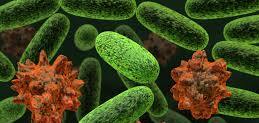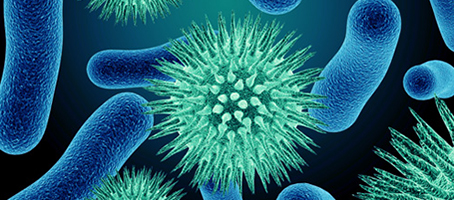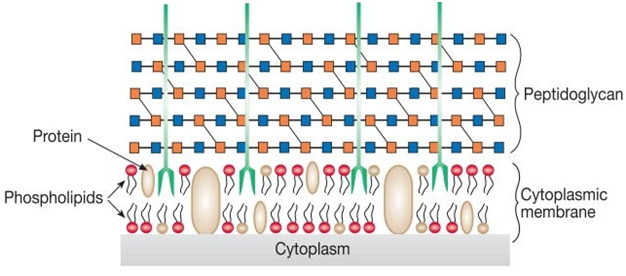Spores are the resistant inactive structures formed by some prokaryotic and eukaryotic organisms. Spore formation is a unique characteristic of bacteria and fungi. They are formed by bacteria especially the Gram-positive organisms when their environmental becomes too harsh for survival such as the loss of nutrients or food scarcity in their normal habitat.
In such harsh environmental conditions, bacteria transform into a dormant state from their original vegetative (growing) state to form spores. Spores are generally the resting forms of bacteria, and they typically continue living as endospores in the environment until when normal growth conditions are formally restored. Thus, the name spores and endospores are synonymously used to mean the same thing.
Endospores therefore are formed by certain groups of bacteria during the process of sporulation, and they connote the lifeless or inactive but viable states of bacteria. They are resistant to environmental stress or shock such as the action of antimicrobial agents, exposure to high temperature and the effect of irradiation amongst other factors in the environment.
However, under suitable environmental conditions necessary for growth (i.e. when the harsh environmental conditions that spurred the sporulating process in the environment are over) the bacterial endospores or spores can revert back to their original vegetative forms through a series of biological processes that include germination.
Sporulation is the process involved in the formation of endospores by a bacterium and it is illustrated in Figure 1. After a long period of existing in the spore-state, bacterial cells in endospore forms can revert back to their vegetative and growing states to form new cells that resemble, and these whole processes occur during the process of germination.
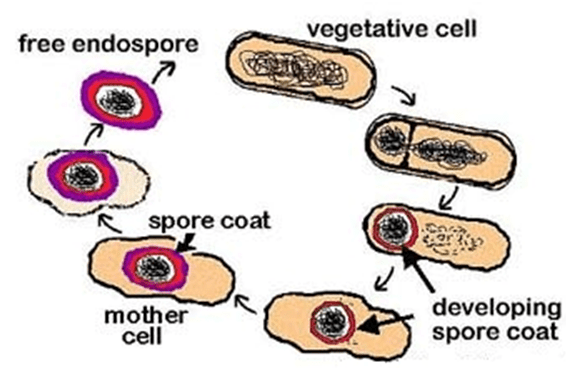
Sporogenesis or sporulation is the process of spore formation in a microbial cell, and it is initiated following nutrient or moisture depletion in the natural habitat of bacteria. During this period, bacterial growth ceases and the organism go into a dormant lifeless but viable form until normal growth conditions are restored again. After a long period of dormancy and following the return of normal growth conditions such as the restoration of nutrient and moisture, bacterial cells in the endospore-state become activated again and germination of the cells begins.
As germination progresses, the cells begin to show outgrowth and the inactive cell finally develop or transforms into a new active and vegetative or growing bacterium. Once germination process has started, the endospore takes up nutrients and water and then swells even as its shell (coat) is shed. The spore sheds its coat and other cell components to form new vegetative cells identical to the original vegetative or parent cell from which the endospore emanated from.
It is noteworthy that the bacterium begins to grow again because of nutrient and moisture uptake amongst other chemical and physical properties of the organism’s immediate environment that spurred growth. But under unfavourable environmental conditions (especially when nutrient becomes depleted again) the bacterial cells can easily revert back to an endospore state to preserve the organism.
Bacillus and Clostridium are usually the two genera of Gram-positive bacteria that form spores. Some other bacteria species apart from these two genera of bacteria can also go into spore formation when their environmental conditions permit it. Spore formation in bacteria is of medical significance. Some of the benefits enjoyed by spore-forming bacteria are as follows:
- Spore formation aids in the spread or transmission of bacteria.
- It helps bacteria to survive harsh environmental conditions such as nutrient depletion and moisture depletion.
- Spore formation play critical role in the pathogenicity and toxicity of some pathogenic bacteria e.g. B. anthracis, B. cereus, C. tetani, and C. botulinum amongst others.
- They also aid in the identification of bacteria in the laboratory.
Microorganisms including bacteria and fungi are very sensitive to changes in their immediate environment especially changes to nutrient depletion, temperature, humidity, pressure and changes in moisture levels. When the environmental disposition of the microorganism is not favourable for growth or reproduction, the organism adjust itself to avoid death or extinction; and one of the ways of doing this is through the formation of spores.
Microorganisms form endospores to seek for alternative resources for survival in their niche/environment; and endospores allows bacteria to survive several unfavourable environmental conditions including but not limited to high temperature, enzymatic destruction, desiccation/dryness, chemical damage and high ultraviolet (UV) irradiation. Endospores are normally formed during the stationary phase of bacteria growth, and it is at this period that nutrient and moisture are usually depleted and unavailable for growth to take place in either a culture medium or in the natural habitat of the organism.
It is noteworthy that most endospores are highly resistant to antimicrobial onslaught, and this feature makes endospores not to be easily killed by antimicrobial action. The whole process of sporulation and germination of endospores to their normal vegetative cells is almost like a two-way phenomenon and something that happens in a back and forth cycle (Figure 2). When nutrients and moisture are adequately available, bacterial growth occurs in an exponential manner but when any of these or both is lacking, bacteria go into an inactive but viable state (i.e. the spore-state) while still maintaining the genetic make-up of the parent cell. Growth still occurs since the organism is lifeless but viable.

In the endospore- state, bacterial cells remain in a non-active but viable form – which is capable of dispersal, survival and growth when favourable environmental conditions are returned in the organism’s natural or artificial environment. Bacterial and fungal organisms that form spores or endospores are easily dispersed from one location to another via air, water or animals. Endospore-forming bacteria are ubiquitously present in the soil, and they are responsible for a plethora of food spoilages and human and animal diseases too.
Some of the characteristic features of endospores and which distinguish them from the vegetative cells are: presence of endospore core (which contains the organism’s chromosome), coat, cortex, spore wall and the presence of exosporium- which is a lipoprotein membrane that contains carbohydrate molecules (Figure 3). Spores or endospores formed in bacteria are located intracellularly at different positions within the mother cell or sporangium.
Morphologically, bacteria spores can be terminally-located, centrally-located or sub-terminally located (Figure 4). Others are located terminally but within a swollen sporangium. The peculiar structure of endospores as shown in Figure 3 makes them to be resistant to antimicrobial treatment, and this gives endospore-forming bacteria including Clostridium species and Bacillus species an edge over non-endospore-forming bacteria such as Escherichia coli in terms of surviving harsh and unfavourable environmental conditions.
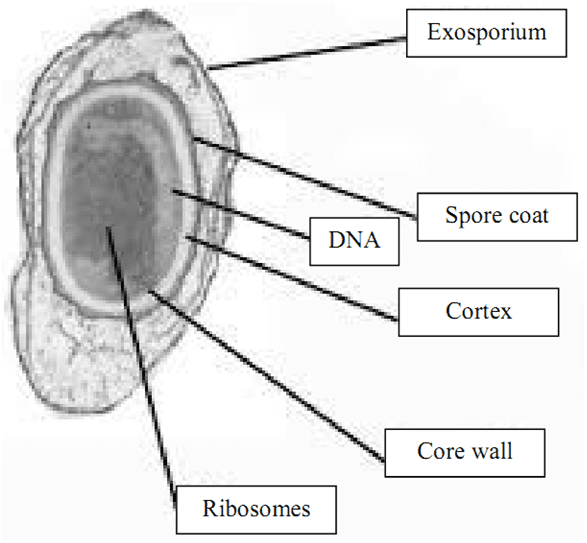

Exosporium is a loose protein coat or outer membrane containing carbohydrate; and which is external to the two innermost layers of the endospore (i.e. spore coat & core wall). Spore coat is a hydrophobic layer rich in cystein; and which protects the internal environment of the endospore and also gives it resistance to harmful substances especially antimicrobial agents. The spore coat is proteinous in nature, and it protects the spore from enzymatic and chemical attacks. DNA is the genetic information of the parent organism.
Cortex is the membranous rigid layer of the endospore that contains the peptidoglycan. The cortex protects the spore from high temperature, and it eventually becomes the cell wall of the bacterium after the spore germination. Core wall is the innermost layer that surrounds the inner endospore membrane; and it contains the chromosome of the vegetative cell but at the spore stage. The core or spore core houses the bacterium’s DNA, and the core is the central part of the endospore. It also contains peptidoglycan layer. Ribosomes are the site for protein synthesis.
References
Alberts B, Bray D, Lewis J, Raff M, Roberts K and Watson J.D (2002). The molecular Biology of the Cell. Fourth edition. New York, Garland, USA.
Berg JM, Tymoczko JL, Stryer L (2002). Biochemistry (5th ed.). New York, NY: W. H. Freeman.
Brooks G.F., Butel J.S and Morse S.A (2004). Medical Microbiology, 23rd edition. McGraw Hill Publishers. USA.
Campbell, Neil A.; Brad Williamson; Robin J. Heyden (2006). Biology: Exploring Life. Boston, Massachusetts: Pearson Prentice Hall.
Cooper G.M and Hausman R.E (2004). The cell: A Molecular Approach. Third edition. ASM Press.
Dale J (2003). Molecular genetics of bacteria. Jeremy W. Dale and Simon Park (4th eds.). John Wiley & Sons Ltd, West Sussex, UK. Pp.
Karp, Gerald (2009). Cell and Molecular Biology: Concepts and Experiments. John Wiley & Sons.
Lodish H, Berk A, Matsudaira P, Kaiser C.A, Kreiger M, Scott M.P, Zipursky S.L and Darnell J (2004). Molecular Cell Biology. Fifth edition. Scientific American Books, Freeman, New York, USA.
Madigan M.T., Martinko J.M., Dunlap P.V and Clark D.P (2009). Brock Biology of microorganisms. 12th edition. Pearson Benjamin Cummings Publishers. USA. Pp.795-796.
Maton, Anthea (1997). Cells Building Blocks of Life. New Jersey: Prentice Hall.
Discover more from Microbiology Class
Subscribe to get the latest posts sent to your email.


